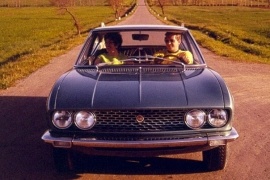FIAT Dino Coupe Models/Series Timeline, Specifications & Photos
First production year: 1967
Engines: Gasoline
Body style: Coupé (two-door)
Named after Enzo Ferrari's son, Alfredo "Dino" Ferrari, Fiat introduced the Dino to help Scuderia Ferrari homologate a V6 engine for Formula 2 racing cars. The car became a legend.
The FIA regulations stated that an engine had to be produced in at least 500 units installed in a production vehicle to be homologated as a racing engine. Ferrari and Fiat signed an agreement in 1965, and a new car was born: the Dino.
Fiat employed Bertone to design the coupe and Pininfarina to create the convertible version. The front fascia featured four round headlights and a black grille between them and a chromed metallic bumper. With its fluid lines and wave-like beltline, the Dino was immediately everybody's darling. An aerodynamic greenhouse with a sloped rear pushed the vehicle into competition against other European sports cars, such as the Peugeot 404 Coupe or the Volvo P1800.
Inside, Fiat installed an unusual-looking instrument panel with two large dials for the tachometer and speedometer in individual casings and five additional gauges for various engine systems such as fuel, coolant temperature, oil pressure, charging, and a clock. The 2+2 seating position was offered with two bucket-seats at the front and two individual seats in the rear, separated by a center armrest.
Fiat installed a 2.0-liter, V6 engine designed by Aurelio Lampredi, who previously made other Ferrari engines. After two years, the Dino received an updated, 2.4-liter unit, with increased power. Fiat fitted the later models with a rear independent suspension to improve cornering speed and comfort.
